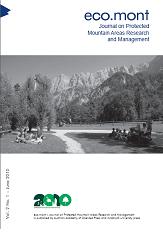
Eco.mont Vol. 2 Nr. 1, pp. 23-30, 2010/05/07
Journal on Protected Mountain Areas Research and Management

Within the Hohe Tauern National Park (Austria), we studied biological soil crusts (BSCs) in the surroundings of the Hochtor and the Großglockner High Alpine Road (2 500 2 600 m). Biological soil crusts (BSCs) consist of cyanobacteria, algae, lichens, and bryophytes, which alter soil factors, including water availability, nutrient content, and susceptibility to erosion. We detected approximately 45 taxa of Cyanoprokaryota and eukaryotic algae, 51 taxa of lichens, and 38 taxa of bryophytes at our study sites, of these the darkcoloured lichen Toniniopsis obscura is dominant. Bryophytes and vascular plants are of minor importance. Compared to uncrusted sites, crust sites exhibit significantly higher contents of organic matter, total nitrogen, and plant-available nutrients. Water storage capacity and aggregate stability are also higher in the crusted soils. Susceptibility to erosion is one fourth lower in crusted soils than in uncrusted soils. Preliminary results also suggest that BSCs are captors for heavy metals as they accumulate higher amounts of atmogenic heavy metals than bare soils.